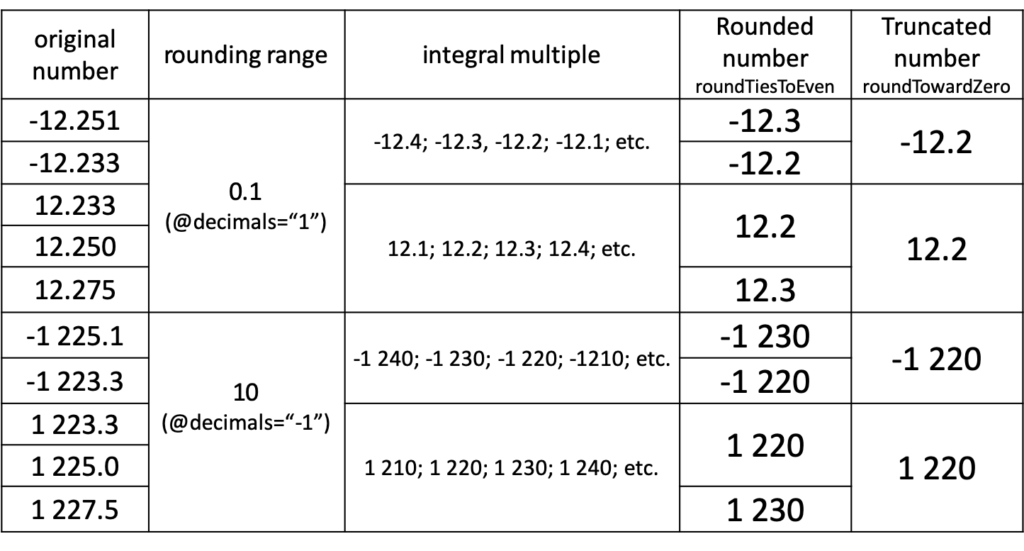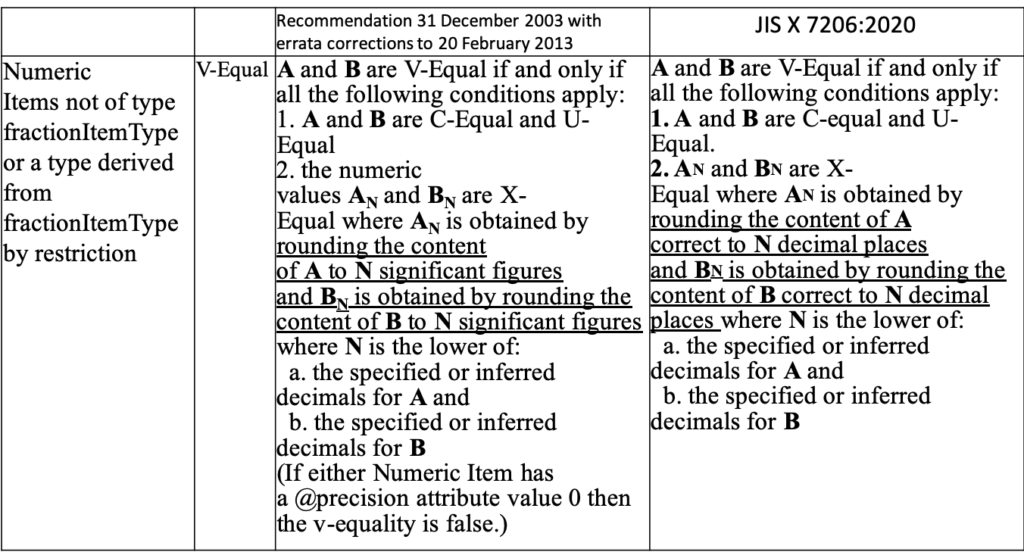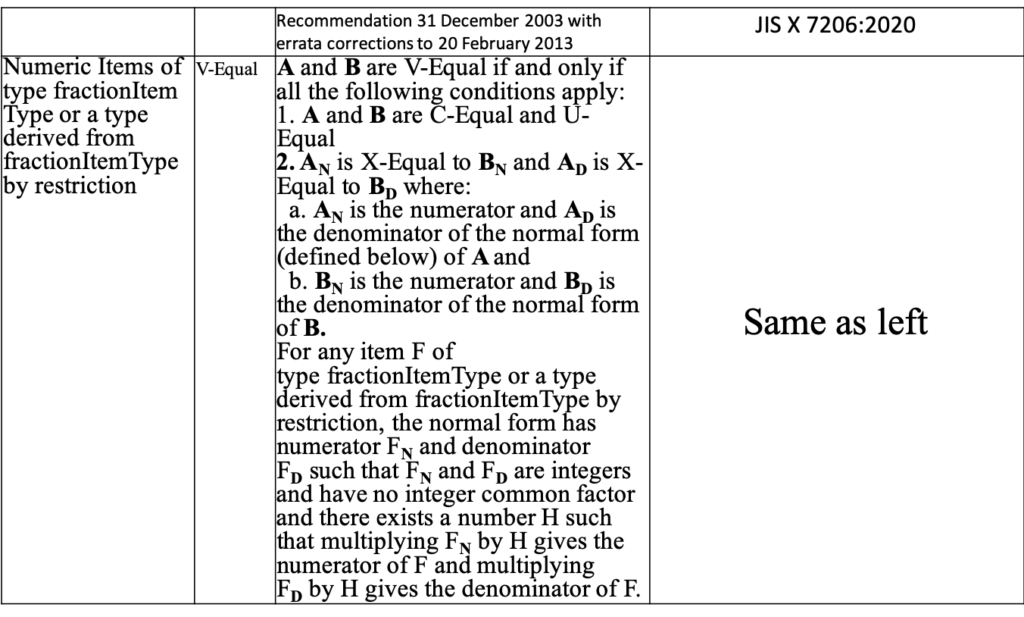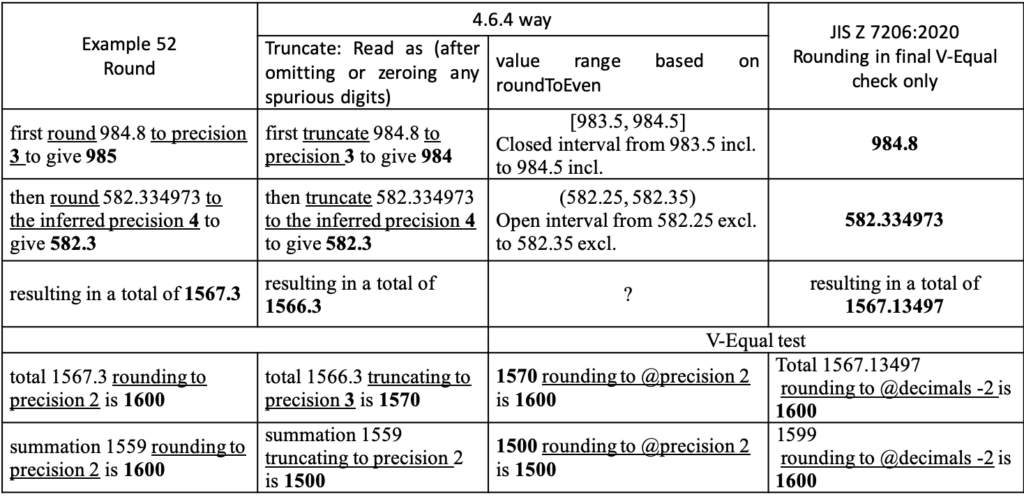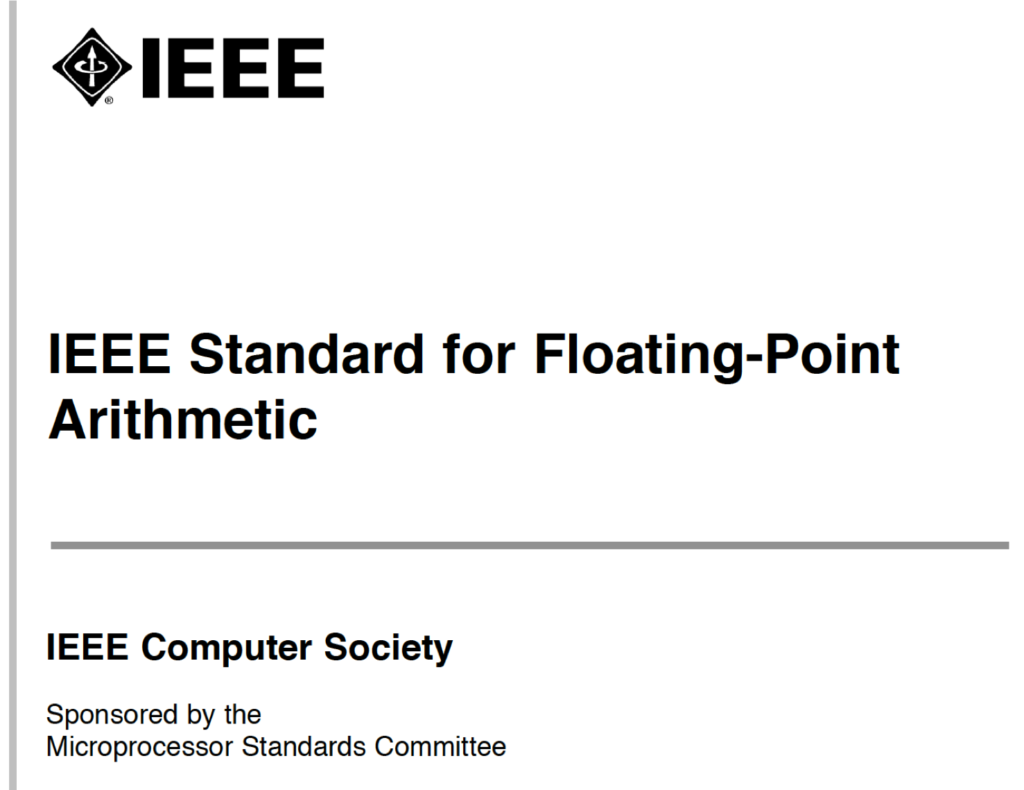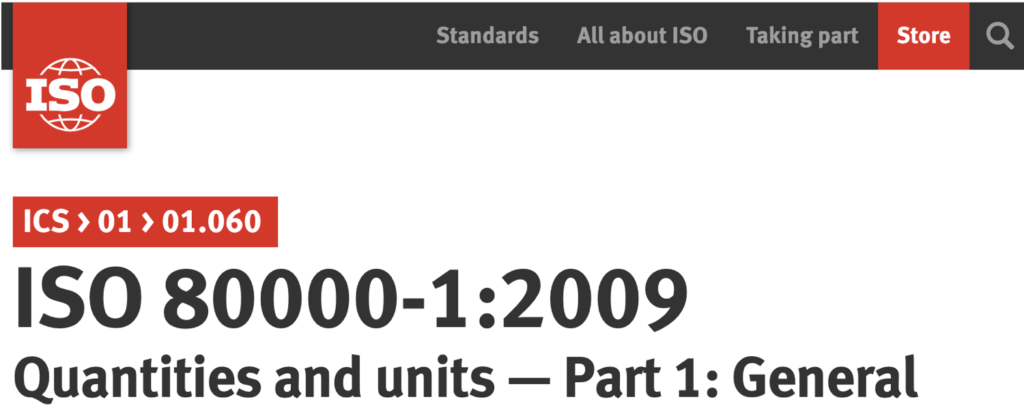Visits: 795
Issues on Spec 2.1
Spec 2.1 is NOT edited sufficiently clear and consistently
21 October 2019
SAMBUICHI Nobuyuki
XBRL Japan Advisor
Representative of JIS X 7206:2020 editorial working group
ISO TC 295 Audit data services
Head of delegate Japanese Industrial Standards Committee
Additional PDF Files for presentation;
Today’s presentation slides(PDF 724KB)
JIS X 7206:2020 4.6.3 ~ 4.6.7 (Translated into English)(PDF 93KB)
References
IETF RFC 2119
IETF (Internet Engineering Task Force). “RFC 2119: Key words for use in RFCs to Indicate Requirement Levels”
Scott Bradner.
(See http://www.ietf.org/rfc/rfc2119.txt)
IEEE
IEEE. “IEEE Standard for Floating Point Arithmetic, IEEE Std 754™-2008”
(See http://ieeexplore.ieee.org/xpl/mostRecentIssue.jsp?punumber=4610933)
This standard is equivalent to following ISO standard
ISO/IEC/IEEE 60559:2011(en)
Information technology — Microprocessor Systems — Floating-Point arithmetic
(see https://www.iso.org/obp/ui/#iso:std:iso-iec-ieee:60559:ed-1:v1:en)
ISO 80000-1
ISO 80000-1:2009
Quantities and units — Part 1: General
(see https://www.iso.org/standard/30669.html)
Errata
74. Changed from inferring precision to inferring decimals
07 March 2011
Section 4.6.6, Section 4.10, Section 5.2.5.2
75. Changed rounding descriptions to IEEE standard recommendation
31 October 2011
Section 4.6.7.1, Section 4.6.7.2
Ambiguous definition for “round” and “truncate”
PREVIOUS RECOMMENDATION – 2003-12-31 + Corrected Errata – 2008-07-02
It is often necessary to round significant figures following a calculation. This is known as rounding. To round a number to n significant figures, discard all digits to the right of the nth place. This step is known as truncation. Then, if the left-most discarded digit is less than 5, leave the nth digit unchanged; if the left-most discarded digit is greater than or equal to 5, add 1 to the nth digit (propagating any carries to digits further to the left according to the normal rules of arithmetic and removing the final 0 if necessary).
CURRENT Recommendation 31 December 2003 with errata corrections to 20 February 2013
It is often necessary to round significant figures following a calculation. This is known as rounding [IEEE] [IEEE 4.3.1 Rounding-direction attributes to nearest, roundTiesToEven]. To round a number to n significant figures, discard all digits to the right of the nth place. This step is known as truncation. Then, if the original number is equally near two truncated numbers, the one with an even nth digit is chosen.
PROBLEM 1
We can not get equally near two truncated numbers with this description.
Discarding all digits to the right of the nth place of original number results a single truncated number.
Requirement level is not clearly stated with statement is known as.
PROBLEM 2
IEEE Std. 754 is not general definition for rounding. It defines rounding for representing floating-point in binary format or decimal format in microprocessor.
Rounding of numbers by JIS X 7206:2020
Clear definition “round” and “truncate” referencing to ISO 80000-1 Annex B
“Rounding” and “Truncation” MUST be performed as specified in [ISO] (ISO80000-1, Annex B Rounding of numbers). Rounding means replacing the magnitude of an original number by another number called the rounded number, selected from the sequence of integral multiples of a chosen rounding range. [IEEE] (IEEE 4.3 Rounding-direction) lists the rounding-direction attribute affects all computational operations that might be inexact.
The first rounding is “Rounding”, and its rounding-direction is “roundTiesToEven”.
If there is only one integral multiple nearest the original number, then that is accepted as the rounded number.
If there are two successive integral multiples equally near the original number. the even multiple is selected as the rounded number. This rule is of special advantage when treating. for example. series of measurements in such a way that the rounding errors are minimized.
The second rounding is “Truncate”, and its rounding-direction is “roundTowardZzero”. An integral multiple closest to and no greater in multitude than infinity precise result the original number is accepted as the truncated number.
Rounding in more than one stage by the application of the rules given above may lead to errors. Therefore, the rounding MUST always be carried out in only one step.
EXAMPLE 12,254 should be rounded to 12,3 and not first to 12,25 and then to 12,2.
The rules given above should be used only if no special criteria for the selection of the rounded number MUST be taken into account. For instance, in case where safety requirements or other limits MUST be respected, it is advisable to round only in one direction.
JIS Z 7206:2010 V-Equal definition
Inconsistency between example 11 and example 52
<a contextRef="c1" unitRef="u1" precision="2">1559</a> <b contextRef="c1" unitRef="u1" precision="3">984.8</b> <c contextRef="c1" unitRef="u1" decimals="1">582.334973</c>
4.6.4 The @precision attribute (optional)
TRUNCATE
If a numeric fact has a @precision attribute that has the value “n” then it is correct to “n” significant figures (see Section 4.6.1 for the normative definition of ‘correct to “n” significant figures’).
An application SHOULD ignore (i.e. replace with zeroes) any digits after the first “n” decimal digits, counting from the left, starting at the first non-zero digit in the lexical representation of any number for which the value of precision is specified or inferred to be n.
Example 52. Calculations involving decimals and precision
ROUND
Suppose that the numeric item a is a summation for numeric items b and c (with weight 1.0) and there exists a context with id ‘c1’ and unit with id ‘u1’ in the instance so that the summation binds.
To perform the calculation, first round 984.8 to precision 3 to give 985 and then round 582.334973 to the inferred precision 4 to give 582.3 resulting in a total of 1567.3. The total is then equal to the summation item after rounding to precision 2 (the precision of the summation item a) at 1600, so that this calculation is consistent.
Consuming application are required to handle inconsistent ways.
The rounding shall always be carried out in only one step.
Modify example 52 to carry out rounding in single step
Example 52. Calculations involving decimals and precision
Suppose that the numeric item a is a summation for numeric items b and c (with weight 1.0) and there exists a context with id ‘c1’ and unit with id ‘u1’ in the instance so that the summation binds.
To perform the calculation, first round 984.8 to precision 3 to give 985 and then round 582.334973 to the inferred precision 4 to give 582.3 resulting in a total of 1567.3. The total is then equal to the summation item after rounding to precision 2 (the precision of the summation item a) at 1600, so that this calculation is consistent.
JIS Z 7206:2020
Suppose that the numeric item a is a summation for numeric items b and c (with weight 1.0) and there exists a context with id ‘c1’ and unit with id ‘u1’ in the instance so that the summation binds.
To perform the calculation, first add 984.8 and 582.334 973 to get 1567.13497, then check if the total is v-equal. The inferred decimals of the summation item a is -2 and 1559 correct to -2 decimal places is1600. The total 1567.13497 correct to -2 decimal places is also1600. These two values are not only both C-Equal and U-equal but also V-Equal, so that this calculation is consistent.
The rounding shall always be carried out in only one step.
The final V-Equal test step.
Calculation based on 4.6.4 vs JIS
Rounding in more than one stage by the application may lead to errors.
Therefore, the rounding MUST always be carried out in only one step for V-Equal test.
IEEE Standard for Floating-Point Arithmetic
4. Attributes and rounding
4.1 Attribute specification
An attribute is logically associated with a program block to modify its numerical and exception semantics. A user can specify a constant value for an attribute parameter. Some attributes have the effect of an implicit parameter to most individual operations of this standard; language standards shall specify ― rounding-direction attributes (see 4.3) and should specify ― alternate exception handling attributes (see Clause 8). Other attributes change the mapping of language expressions into operations of this standard; language standards that permit more than one such mapping should provide support for: ― preferredWidth attributes (see 10.3) ― value-changing optimization attributes (see 10.4) ― reproducibility attributes (see Clause 11). For attribute specification, the implementation shall provide language-defined means, such as compiler directives, to specify a constant value for the attribute parameter for the operations in a block; the scope of the attribute value is the block with which it is associated. Language standards shall provide for constant specification of the default and each specific value of the attribute.
4.2 Dynamic modes for attributes
Attributes in this standard shall be supported with the constant specification of 4.1. Particularly to support debugging, language standards should also support dynamic-mode specification of attributes. With dynamic-mode specification, a user can specify that the attribute parameter assumes the value of a dynamic-mode variable whose value might not be known until program execution. This standard does not specify the underlying implementation mechanisms for constant attributes or dynamic modes. For dynamic-mode specification, the implementation shall provide language-defined means to specify that the attribute parameter assumes the value of a dynamic-mode variable for the operations within the scope of the dynamic-mode specification in a block. The implementation initializes a dynamic-mode variable to the default value for the dynamic mode. Within its language-defined (dynamic) scope, changes to the value of a dynamic-mode variable are under the control of the user via the operations in 9.3.1 and 9.3.2. The following aspects of dynamic-mode variables are language-defined; language standards may explicitly defer the definitions to implementations: ― The precedence of static attribute specifications and dynamic-mode assignments. ― The effect of changing the value of the dynamic-mode variable in an asynchronous event, such as in another thread or signal handler. ― Whether the value of the dynamic-mode variable can be determined by non-programmatic means, such as a debugger. NOTE—A constant value for an attribute can be specified and meet the requirements of 4.1 by a dynamic mode specification with appropriate scope of that constant value.
4.3 Rounding-direction attributes
Rounding takes a number regarded as infinitely precise and, if necessary, modifies it to fit in the destination’s format while signaling the inexact exception, underflow, or overflow when appropriate (see Clause 7). Except where stated otherwise, every operation shall be performed as if it first produced an intermediate result correct to infinite precision and with unbounded range, and then rounded that result according to one of the attributes in this clause. Except where stated otherwise, the rounding-direction attribute affects all computational operations that might be inexact. Inexact numeric floating-point results always have the same sign as the unrounded result. The rounding-direction attribute affects the signs of exact zero sums (see 6.3), and also affects the thresholds beyond which overflow (see 7.4) and underflow (see 7.5) are signaled. Implementations supporting both decimal and binary formats shall provide separate rounding-direction attributes for binary and decimal, the binary rounding direction and the decimal rounding direction. Operations returning results in a floating-point format shall use the rounding-direction attribute associated with the radix of the results. Operations converting from an operand in a floating-point format to a result in integer format or to an external character sequence (see 5.8 and 5.12) shall use the rounding-direction attribute associated with the radix of the operand. NaNs are not rounded (but see 6.2.3).
4.3.1 Rounding-direction attributes to nearest
In the following two rounding-direction attributes, an infinitely precise result with magnitude at least bemax ×(b−½b1−p ) shall round to ∞ with no change in sign; here emax and p are determined by the destination format (see 3.3). With:
― roundTiesToEven, the floating-point number nearest to the infinitely precise result shall be delivered; if the two nearest floating-point numbers bracketing an unrepresentable infinitely precise result are equally near, the one with an even least significant digit shall be delivered; if that is not possible, the one larger in magnitude shall be delivered (this can happen for one-digit precision, possible with convertToDecimalCharacter for example, as when rounding 9.5 to one digit in which case both 9 and 1×101 have odd significands)
― roundTiesToAway, the floating-point number nearest to the infinitely precise result shall be delivered; if the two nearest floating-point numbers bracketing an unrepresentable infinitely precise result are equally near, the one with larger magnitude shall be delivered.
4.3.2 Directed rounding attributes
Three other user-selectable rounding-direction attributes are defined, the directed rounding attributes roundTowardPositive, roundTowardNegative, and roundTowardZero. With:
― roundTowardPositive, the result shall be the format’s floating-point number (possibly +∞) closest to and no less than the infinitely precise result
― roundTowardNegative, the result shall be the format’s floating-point number (possibly −∞) closest to and no greater than the infinitely precise result
― roundTowardZero, the result shall be the format’s floating-point number closest to and no greater in magnitude than the infinitely precise result.
4.3.3 Rounding attribute requirements
An implementation of this standard shall provide roundTiesToEven and the three directed rounding attributes. A decimal format implementation of this standard shall provide roundTiesToAway as a user selectable rounding-direction attribute. The rounding attribute roundTiesToAway is not required for a binary format implementation. The roundTiesToEven rounding-direction attribute shall be the default rounding-direction attribute for results in binary formats. The default rounding-direction attribute for results in decimal formats is language-defined but should be roundTiesToEven.
ISO 80000-1:2009(E)
Quantities and units – Part 1 General
Annex B
(normative)
Rounding of numbers
B.1 Rounding means replacing the magnitude of a given number by another number called the rounded number, selected from the sequence of integral multiples of a chosen rounding range.
B.1 Rounding means replacing the magnitude of a given number by another number called the rounded number, selected from the sequence of integral multiples of a chosen rounding range.
EXAMPLE 1
| rounding range: | 0,1 |
| integral multiple: | 2,1; 12,2; 12,3; 12,4; etc. |
EXAMPLE 2
| rounding range: | 10 |
| integral multiple: | 1 210; 1 220; 1 230; 1 240; etc. |
B.2 If there is only one integral multiple nearest the given number, then that is accepted as the rounded number.
EXAMPLE 3
| rounding range: | 0,1 |
| given number | rounded number |
| 12,233 | 12,2 |
| 12,251 | 12,3 |
| 12,275 | 12,3 |
EXAMPLE 4
| rounding range: | 10 |
| given number | rounded number |
| 1 223,3 | 1 220 |
| 1 225,1 | 1 230 |
| 1 227,5 | 1 230 |
B.3 If there are two successive integral multiples equally near the given number, two different rules are in use.
Rule A: The even multiple is selected as the rounded number.
EXAMPLE 5
| rounding range: | 0,1 |
| given number | rounded number |
| 12,25 | 12,2 |
| 12,35 | 12,4 |
EXAMPLE 6
| rounding range: | 10 |
| given number | rounded number |
| 1 225,0 | 1 220 |
| 1 235,0 | 1 240 |
Rule B: The greater in multitude is selected as the rounded number.
EXAMPLE 7
| rounding range: | 0,1 |
| given number | rounded number |
| 12,25 | 12,3 |
| 12,35 | 12,4 |
| -12,25 | -12,3 |
| -12,35 | -12,4 |
EXAMPLE 8
| rounding range: | 10 |
| given number | rounded number |
| 1 225,0 | 1 230 |
| 1 235,0 | 1 240 |
| -1 225,0 | -1 230 |
| -1 235,0 | -1 240 |
Rule A is generally preferable and of special advantage when treating, for example, series of measurements in such a way that the rounding errors are minimized.
Rule B is sometimes used in computers.
B.4 Rounding in more than one stage by the application of the rules given above may lead to errors. Therefore, the rounding shall always be carried out in only one step.
EXAMPLE 12,254 should be rounded to 12,3 and not first to 12,25 and then to 12,2.
